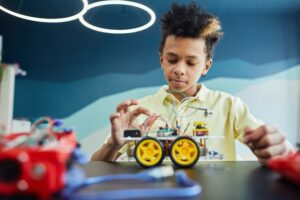Virtual reality (VR) is a prevalent technology in several industries, including consumer electronics and gaming, health care, tourism, architecture, interior design and more. Another sector that can greatly benefit from using VR in education.
Bringing VR into the classroom offers several benefits for educators and their students. It supports active learning, sparks creativity, encourages student interest in STEM (science, technology, engineering and math) topics and places students in immersive learning environments. How do teachers typically use VR for educational purposes?
Explore the best ways you can use VR for your students.
“Schools using VR allow teachers to bring their students on a virtual field trip to some of the world’s most popular locations.”
1. Take Virtual Field Trips
Traditionally, educators had the opportunity to take students on field trips to museums, planetariums, zoos, national parks and other places. However, these excursions became less frequent due to limited school budgets and the COVID-19 pandemic.
Schools using VR allow teachers to bring their students on a virtual field trip to some of the world’s most popular locations. Google Art and Culture Expeditions is useful for educators interested in virtual field trips.
2. Explore Outer Space
Anyone can travel into outer space and beyond in only a few seconds with the right VR hardware. Students can learn about stars, planets, solar systems and what it’s like to be an astronaut. Many of the best VR space experiences are highly interactive, so students will remain engaged and retain information better.
3. Create Interactive Classroom Activities
One VR application, Flipgrid, allows educators to offer interactive activities for students by printing QR codes. Teachers can visit the Flipgrid dashboard to select a topic they want to cover. The app will print a QR code and the teacher can place it anywhere in the classroom.
Suppose students have access to laptops or tablets, two increasingly important digital tools in the classroom. In that case, they can scan the QR code using the device’s camera and complete the activity accordingly.
“Students can use headsets to experience what a real-life job interview is like and develop skills along the way.”
4. Engage in Role-Play Learning
VR is becoming increasingly affordable, but private schools are more likely to have the latest technologies than public schools. However, students in both settings have different learning styles.
One teaching method is role-play learning. Combining this with virtual reality is a great way to use VR in the classroom. For instance, students can use headsets to experience what a real-life job interview is like and develop skills along the way.
5. Visualize Scientific Concepts
VR can be used in a classroom to teach students more about scientific topics. For example, they can roam among the dinosaurs, see the world from an animal’s perspective or experience kinetic energy transfer on a roller coaster. There are limitless scientific applications in the real world. There’s no better way to teach students about these concepts than with an immersive VR experience.
6. Study a New Language
Learning a foreign language can be challenging. However, being fluent in more than one tongue is a valuable skill for students to develop. Kids can interact with each other and practice speaking a new language without experiencing pressure or nervousness like they might with strangers. ImmerseMe is a popular VR educational tool to assist you with teaching a language.
7. Develop Practical Skills
Many schools offer home economics, cooking or life skills classes. These courses allow students to gain practical skills they’ll need for the rest of their lives. VR can also assist kids in these classes. They can follow recipes and cook meals independently if the classroom has no kitchen. They can also learn how to change a tire with VR. See what practical skills you want to teach and explore what tools will help you do so.
“If they read a particular book, you can assign them to recreate its setting.”
8. Build Fictional Settings
Another engaging way to use VR is to create fictional, immersive environments for your students. For example, if they read a particular book, you can assign them to recreate its setting. This will evaluate their level of reading comprehension and allow them to use software to create a VR environment.
Leveraging VR to Create Exceptional Learning Experiences
VR has many applications in an educational setting, and this list contains some of the best ways to use this revolutionary technology in the classroom. Students will feel more engaged with your curriculum, get excited about going to school and may even retain information better. If you’re interested in VR, consider introducing it into your classroom using some of these suggestions.
Also, Read How VR Technology Can be Used to Improve Retail
- AI
- ai art
- ai art generator
- ai robot
- AIIOT Technology
- AR/VR
- artificial intelligence
- artificial intelligence certification
- artificial intelligence in banking
- artificial intelligence robot
- artificial intelligence robots
- artificial intelligence software
- blockchain
- blockchain conference ai
- coingenius
- conversational artificial intelligence
- crypto conference ai
- dall-e
- deep learning
- Education
- google ai
- machine learning
- plato
- plato ai
- Plato Data Intelligence
- Plato Game
- PlatoData
- platogaming
- scale ai
- zephyrnet













